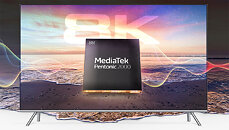Monday, November 22nd 2021
MediaTek's Pentonic 2000 is World's first TV SoC with H.266 support
With ever increasing computational needs from TV SoCs, as we're moving towards higher resolutions and refresh rates, MediaTek is getting ready for the next generation of 8K TVs with its new Pentonic 2000 SoC. This is the world's first TV SoC to support the new H.266 video codec standard, which is an evolution of the H.265 intended for 8K content.
The Pentonic 2000 is fabbed using TSMC's N7 node and it's the first commercial TV SoC to be made on this manufacturing process according to MediaTek. The SoC supports 8K resolution content at up to 120 Hz with MEMC (Motion Estimation, Motion Compensation) and has an integrated AI engine to help improve scaling from lower resolutions. MediaTek also claims that the Pentonic 2000 features the "industry's most powerful CPU and GPU" in a smart TV SoC, without giving away any actual details, although it the SoC does support UFS 3.1 storage, which suggests that we're looking at a recent Arm Cortex-A7x based SoC at the very least.Outside of H.266 support - also known as VVC (Versatile Video Coding) - the Pentonic 2000 will decode AV1 which has become the defacto standard for Netflix and many other streaming services, H.265, VP9, AVS3 and most likely also many older codecs. MediaTek has also added support for WiFi 6E, 5G as an option and obviously HDMI 2.1 to the Pentonic 2000. As you would expect, there's also support for voice control with support for up to four directional microphones, although MediaTek doesn't specify which voice assistants that are supported. Another party trick on offer is 16-screen picture-in-picture support, although this seems more useful for some commercial applications than watching multiple shows at once. Don't expect TV makers to be touting the fact that they're using the Pentonic 2000 in their TV's next year though, as they're likely to call it something else, or not mention it all.
Source:
MediaTek
The Pentonic 2000 is fabbed using TSMC's N7 node and it's the first commercial TV SoC to be made on this manufacturing process according to MediaTek. The SoC supports 8K resolution content at up to 120 Hz with MEMC (Motion Estimation, Motion Compensation) and has an integrated AI engine to help improve scaling from lower resolutions. MediaTek also claims that the Pentonic 2000 features the "industry's most powerful CPU and GPU" in a smart TV SoC, without giving away any actual details, although it the SoC does support UFS 3.1 storage, which suggests that we're looking at a recent Arm Cortex-A7x based SoC at the very least.Outside of H.266 support - also known as VVC (Versatile Video Coding) - the Pentonic 2000 will decode AV1 which has become the defacto standard for Netflix and many other streaming services, H.265, VP9, AVS3 and most likely also many older codecs. MediaTek has also added support for WiFi 6E, 5G as an option and obviously HDMI 2.1 to the Pentonic 2000. As you would expect, there's also support for voice control with support for up to four directional microphones, although MediaTek doesn't specify which voice assistants that are supported. Another party trick on offer is 16-screen picture-in-picture support, although this seems more useful for some commercial applications than watching multiple shows at once. Don't expect TV makers to be touting the fact that they're using the Pentonic 2000 in their TV's next year though, as they're likely to call it something else, or not mention it all.

16 Comments on MediaTek's Pentonic 2000 is World's first TV SoC with H.266 support
This is more for tier two brands.
Keep in mind that MediaTek bought MStar some years ago, who was/is the leader in low-cost TV chips.
If 8K was a must-have feature, the reactions would be different but most people I know with the (now standard) 4K TV resolution stick to 1080p because either the bandwidth requirements of 4K aren't high enough to be worth it, the 4K encoding is too compressed to be worth it, the 4K option is paywalled for a price premium and not worth it, or the original content itself simply isn't sharp enough or in-focus enough to take advantage of the extra pixels.
Sports, maybe, might be where it's needed but I think 1080p120 is better for most sports than extra resolution as they tend to contain either static images where focus is on the tracking of a tiny ball (eg tennis) or they have very rapid panning/zooming camerawork and framerate is way more important than resolution.
Sony's new BRAVIA TVs pack advanced AI with Cognitive Processor XR - SlashGear
Sony had XR processor and a separate mediatek co-processor, since x900h its all handled by a single mediatek chip.
I found this interesting as I didn't even know H.266 was a thing, and regardless of resultion better compression is usually always good when HW support comes but as everyone moves to AV1 I don't know how much traction H.266 will be able to gain, at least they seem to have learned from the mistakes of H.265 and made it royalty free (at least in some ways)